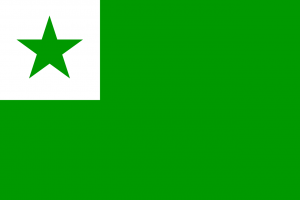Language/Esperanto/Vocabulary/Count-to-10
Hi Esperanto learners! 😊
In this lesson, we will learn how to count to 10 in Esperanto. Numerals are a fundamental vocabulary base that we all need to master in any language. Once you memorize these numbers, you are ready to count in Esperanto! So let's start!
With the completion of this lesson, consider investigating these related pages: Animal, Basic Phrases in Esperanto, Weather & Restaurant.
Cardinal Numbers[edit | edit source]
Cardinal numbers are used to represent the quantity of a matter. In Esperanto, we use a base-10 system like many other languages.
Let's take a look at the cardinal numbers from 1 to 10 in Esperanto:
| Esperanto | Pronunciation | English |
|---|---|---|
| unu | "oo-noo" (IPA: /'u.nu/) | one |
| du | "doo" (IPA: /du/) | two |
| tri | "tree" (IPA:/tri/) | three |
| kvar | "kvar" (IPA:/kvar/) | four |
| kvin | "kvin" (IPA:/kvin/) | five |
| ses | "sehss" (IPA:/ses/) | six |
| sep | "sep" (IPA:/sep/) | seven |
| ok | "ohk" (IPA:/ok/) | eight |
| naŭ | "nah-oo" (IPA:/'na.ou/) | nine |
| dek | "dek" (IPA:/dek/) | ten |
Note that the pronunciation given in this lesson follows the official pronunciation used by the Academy of Esperanto, but a slightly different pronunciation may be used by some speakers.
Now let's use these numbers in action!
A common way to use numbers is when telling the time. Here is an example dialogue:
- Person 1: Kioma horo estas? ("What time is it?")
- Person 2: Estas la tria. ("It's three o'clock.")
Another way to use numbers is when giving your phone number:
- Person 1: Kiuj estas viaj telefonaj numeroj? ("What are your phone numbers?")
- Person 2: Mia numero estas tri kvar naŭ kvin naŭ ok sep ok naŭ dek. ("My number is 3-4-9-5-9-8-7-8-9-10.")
Cultural Information[edit | edit source]
Esperanto was created by L.L. Zamenhof in the late 19th century in attempts to facilitate communication among speakers of different languages. It was designed to be a second language that would be easier to learn than any national language, thereby fostering harmony between people from different countries and preventing future wars.
Today, there are over 2 million Esperanto speakers worldwide! It is a language for everybody- young and old, rich and poor, anyone is free to learn and speak it. You can attend national and international Esperanto events such as conventions or cultural events Polyglot Club.
Interesting facts[edit | edit source]
- The word "unu" (one) sounds similar in many languages, such as "uno" in Italian, "un" in French or "eins" in German, as they all stem from the same Indo-European language family. - Esperanto has 28 letters, with the majority of letters resembling the letters of the English alphabet, but there are six additional letters in Esperanto: ĉ, ĝ, ĥ, ĵ, ŝ, and ŭ.
Recap[edit | edit source]
Congratulations! You have now learned how to count to 10 in Esperanto. To reinforce your new knowledge, practice counting as often as possible: when you are waiting for the bus, in the shower, or when you are baking a cake. To improve your Esperanto Vocabulary, you can also use the Polyglot Club website. Find native speakers and ask them any questions!
➡ If you have any questions, please ask them in the comments section below.
➡ Feel free to edit this wiki page if you think it can be improved. 😎
Sources[edit | edit source]
Videos[edit | edit source]
Counting Numbers in Esperanto (Unu, Du, Tri, etc.) - YouTube[edit | edit source]
Other Lessons[edit | edit source]
- Oceans and Continents
- Vehicles
- Dinner Table
- Weathers
- Fruits
- Animals
- Motorcycle
- Constellations
- Problems in Esperanto
- Measurement

